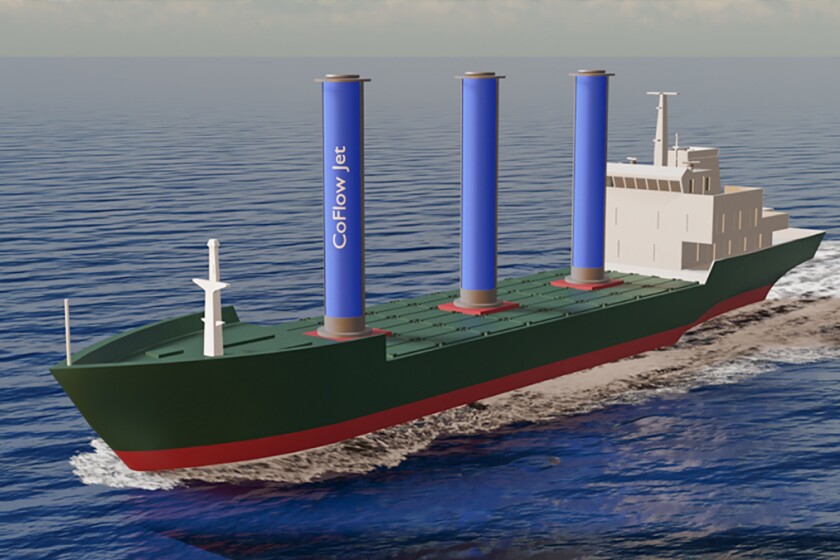
Posted on 08/02/2024 11:16:26 AM PDT by Red Badger

Artist's concept of a ship with the CoFlow system
Looking like a set of bridge supports that were accidentally installed on a cargo ship, a new wind-driven system by startup CoFlow Jet promises to reduce ship fuel costs by up to 90% using stationary cylinders with no moving parts.
Between rising fuel costs and increasing government mandates requiring shipping companies to go carbon neutral by 2050, there's a strong push to increase the efficiency of cargo ships while reducing their emissions. One way of doing this is to take a page from the history books and readopt sails to harness the wind.
On the surface, that makes sense. Sails have been propelling ships all over the world for millennia and were still used for commercial transport until after the Second World War. However, there are two problems with sails that have pushed them out of the cargo market for all except the most local of niches.
First, traditional sails require huge crews. Something the size of the 921-tonne tea clipper Cutty Sark needed a crew of about 30 to handle the sails and the complex sheets and lines that controlled them. Compare that to a modern 196,000-tonne container ship that needs only 13 officers and sailors – and most of them are pushing buttons instead of hauling lines.
The second problem is that sails are completely dependent on the wind. If the wind is blowing hard enough and in the right direction, great. If it's blowing too little or too hard, or if it's blowing from the wrong quarter, that's not so great. If it's not blowing at all, you're not going anywhere.
(Excerpt) Read more at newatlas.com ...
I detect a Beano commercial any time now.



-PJ
Thanks for clarifying. So is it the motion of air molecules flowing across the boat because the boat is in motion (air flowing from front to back)? It seems like that would create as much or more drag than it'd recapture. Or are the air molecules in motion from wind coming from the side?
Prefect!
This has been around for a hundred years. Nothing new. See posted images of actual ships, not computer generated pics..................
These can be retrofitted and aren’t they merely for use when practical while not giving up the engines for all other times?
“Reinventing the slow boat from china.”
Why do people make stupid comments about things they don’t understand?
Folks,
If you do any research on this:
1) It is driven by the green /climate change movement. Not economics.
2) It may be appropriate Technoloy for appropriate situations. Just like electric cars are.
3) It will fail as the it is being promoted as one size fits all, just like everything else. Instead of letting the market place make the decisions.
4) Idiots think you just need a small propulsion system to get in and out of the harbor.
I think those are tankers.
Ironic as hell....................
The article was poorly at best, written. It reads like a puff piece for some subsidized DOE project funded by xiden or maybe buttgig. Find the engineering document and post that, then we might have a conversation. Till then.........>
Nice AI-generated “generic image of a tower-driven cargo ship”.
But, you see, such towers cannot drive any common container ship - the containers cannot be unloaded when a tower is installed, the tower interferes with the container cranes, the towers prevent entry into most harbors (too tall for the bridges), if installed and mounted on deck, the towers are blocked from the lower stacks of containers. If mounted on deck, no containers can be loaded in the spaces below the fixed tower foundations.
I have stood on ships while underway, their self-wind at 15 - 20 knots from the diesels driving propellers is a strong force that must pushed through by the diesel. (Yes, not the full thrust - most propeller physically is moving the hull through the water.)
Also. Center of gravity when the hull is unloaded and a sideways wind or waves is present? Capsize happened recently on North Sea ferries, car ferries, even cruise ships.
Back in the 1840s, no ship departure schedule could even be imagined until steam engines and steam paddlewheel tugs became practical. Arrival times? Unpredictable even more so.
And if you had even comprehended the headline..........................
It’s not new. It’s been around for a hundred years. See posted pics of actual ships ...............................
-PJ
Because it’s Friday and the know it alls are out.
” So is it the motion of air molecules flowing across the boat because the boat is in motion (air flowing from front to back)? “
The pressure difference around the cylinder causes a deflection in the motion of air molecule in a direction that provides forward motion.
This is new to me but a conventional sail does not impart all force in the forward direction.
“It’s not new. It’s been around for a hundred years. See posted pics of actual ships ...............................”
Those are Flettner rotors. Not the same.
And going beyond what you have pointed out, why didn’t rotor sails catch on a hundred years ago so that every ship afloat today would have “Cylinder sails” as they call it?
The artist renderings are of dry bulk carriers, not tankers or container ships.
The idea of excluding dry bulk carriers from the category “cargo ships” is absurd.
Disclaimer: Opinions posted on Free Republic are those of the individual posters and do not necessarily represent the opinion of Free Republic or its management. All materials posted herein are protected by copyright law and the exemption for fair use of copyrighted works.